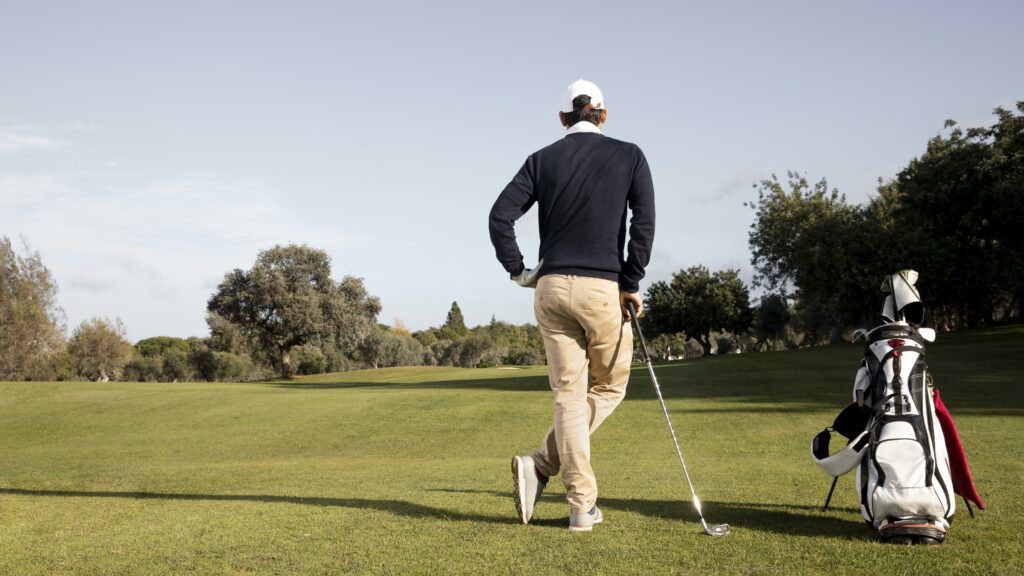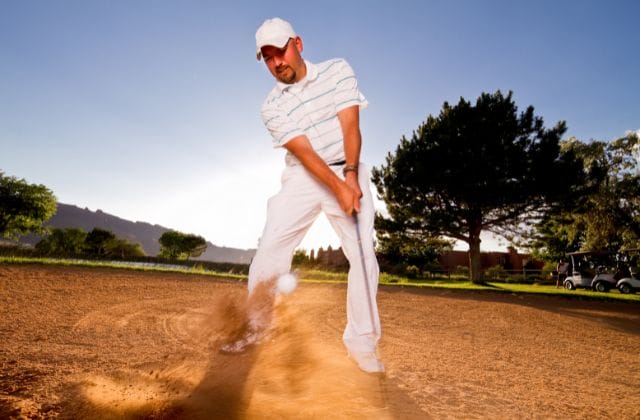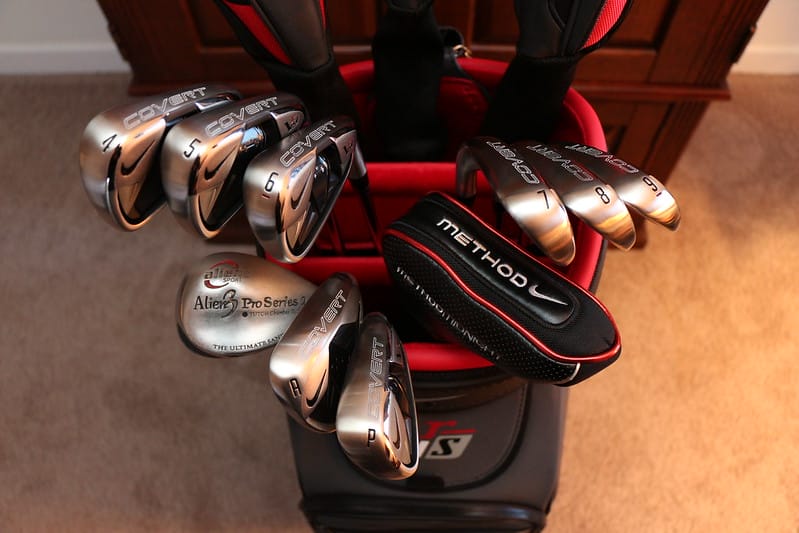As a golfer, you are only going to be able to put 14 clubs in your own bag.
The great thing about the 14 club rule is that it is fair for everyone involved. It does not matter if your handicap is a 30 or a two; you will still be able to carry 14 clubs.
The tricky part can be knowing what clubs are the must have golf clubs. Which are the ones that are worthy of having their own space in your own bag.
For an average golfer, these are the clubs that would typically be in their bag.
- Driver
- 3 and 5 Wood
- 4 Hybrid
- 5, 6, 7, 8 and 9 Iron
- Pitching Wedge
- Gap Wedge/Approach Wedge
- Sand Wedge
- Lob Wedge
- Putter
In this guide I cover:
- The must-have clubs to carry in your bag if you are a high, mid, or low handicap.
- How to customize your golf bag based on your strengths and weaknesses
- How to best prepare your golf bag for a variety of different course conditions
- Answers to some of the most important FAQs.
Let’s tee off!
What Clubs Should Be In My Golf Bag?

A golfer’s skill level is going to help determine the exact set makeup for their golf bag. A high handicapper and a low handicapper need to carry different clubs.
This is because of the different strengths and weaknesses they will have in their game.
High Handicapper

- Driver
- 3 and 5 Wood
- 4, 5 and 6 Hybrid
- 7-PW
- Gap Wedge
- Sand Wedge
High handicappers generally need to focus on two things, forgiveness and distance.
Golfers that have high handicappers should not put long irons in their bag, and they should rely on their fairway woods at times off the tee.
Many golf professionals believe that a high handicapper should not put a driver in their bag. This is not a theory that I believe in.
Most high handicappers are on a quest to become mid handicappers; eventually, they will have to learn how to release a driver and hit it straight down the fairway. Keeping it out of the bag does not allow for this.
Some high handicappers forget to equip themselves for the short game properly. These game is where all of the scoring shots happen.
Having pitching wedges in your bag is certainly not good enough. High handicappers need an assortment of pitching wedges and a forgiving mallet putter along with other necessary golf accessories like golf balls.
Mid Handicapper
- Driver
- 3 and 5 Wood
- 4 Hybrid
- 5-PW
- Gap Wedge
- Sand Wedge
- Lob Wedge
Mid handicappers need a mix of forgiveness and scoring clubs. Some of the long irons get a bit difficult for mid handicappers to hit the golf balls because many will lack the club head speed necessary to hit them consistently.
A mid handicapper should have a mix of irons, hybrids, and woods. Mid handicappers should consider their golf shaft choices very carefully.
This is where you may see that a golfers bag has stiff shafts in the woods but regular in the irons. Make sure that the shafts match the ability of the players.
When it comes to wedges, mid handicappers should carry the same number of wedges that the lower handicappers use.
Most of the time, a mid handicapper is looking to make it to the low handicap level eventually.
If this is the case, you will need to know how many clubs in your bag is sufficient that can help you score.
Putters for mid handicappers can be either blade or mallet style putters.
This is going to come down to a matter of preference at this point. Mid handicappers will want to look for golf clubs that are cavity back in style and have some forgiving features that make them easier to hit.
Low Handicapper

- Driver
- 3 Wood
- 3 Hybrid
- 4-PW
- 52 degree gap wedge
- 56 degree sand wedge
- 60 degree lob wedge
As you probably noticed, the low handicappers are the only ones that we recommend carry long irons. In fact, our list says that a low handicapper should keep the four iron in the bag, but many will also keep the three iron in the bag.
It takes a lot of swing speed and precision to hit long irons properly. Lower handicap players tend to have the abilities necessary to hit these types of shots.
The types of clubs that lower handicap golfers use are going to be more of a blade style club. Their strong points will be precision, spin, and workability but not forgiveness.
Low handicap players need to use high performing wedges in their bag.
These clubs are going to be what helps them score and what makes the difference in the score should they get into some trouble.
Overall a lower handicap player is going to have more irons and wedges in the bag than both the mid and the high handicappers.
Some low handicappers don’t enjoy hybrids, and they will carry two fairway woods instead.
We still consider a hybrid one of the essential golf clubs to keep in your bag.
Customizing Your Golf Bag Based on Your Strengths and Weaknesses
Next, I will discuss what clubs to carry in your bag based on your individual strengths and weaknesses.
Short Game
It is imperative golfers of all abilities come equipped for the short game; after all, it’s where all the scoring shots happen.
Most of the shots you hit on the golf course are in relative proximity to the green, so make sure you pack the right clubs for the job (in this case, wedges are your best friend).
Wedges are the clubs that are going to make the biggest difference to your mastery of the short game, as they offer deft control and finesse in a variety of different scenarios.
That’s why you should at the very least be packing a Sand wedge and a Lob wedge in your golf bag.
Sand wedge
Sand wedges, as the name suggests, are designed to help you out of bunkers.
With the widest sole of any wedge and a loft between 54 and 56 degrees, this club will most definitely come in handy should your hole not go to plan.
Lob wedge
Lob wedges have a loft between 58 and 64 degrees (although they can get as high as 72 degrees), making them an invaluable club for getting out of sticky situations.
If you need to navigate the ball over obstacles and make it stop quickly on the green, this will be the club you call up.
Distance
To put yourself in a position where you can then use a sand wedge or a lob wedge, you’re going to have to get your ball moving off the tee.
Luckily, there are a host of different types of golf clubs designed for distance, such as drivers, fairway woods, hybrids, and irons.
Driver with an appropriate loft (usually 9-11 degrees)
When choosing a driver, it is crucial to take loft into consideration.
For most players, having a driver with substantial loft will be beneficial in terms of hitting the ball further, reducing slice, and generating bounce (which could help your shot evade bunkers).
A driver with a loft of between 9 and 11 degrees should prove sufficient.
Fairway woods
Where drivers provide maximum power and distance, fairway woods have the more balanced attributes of distance and control.
These clubs are designed for shots of the turf or fairway still a considerable distance from the hole. A rule of thumb I go by is if I am close to 200 yards away from the green, I will use my fairway wood.
Hybrids
Hybrid clubs bridge the gap between fairway woods and irons.
While they offer similar ball play to fairway woods, they are more usable, as well as having a certain forgiveness that irons might lack from a similar distance.
They offer a good option from medium to long range and perform better out of the rough than a wood does, given their wider loft variation.
Irons
Irons are essential for precision from mid-range. They range from long irons (2, 3 and 4), to mid irons (5, 6 and 7), to short irons (8 and 9).
The lower the number, the lower the shot and the longer the distance. The higher the number, the higher the ball flight and the shorter the distance. The versatility offered by irons will add a much more dynamic element to your mid to short-range game.
Shot Shape
Golf balls almost always curve when traveling through the air. The nature of this curve determines the shape of the shot.
The main shot shapes are draws where the ball starts outside the target line and before curving in, and fades where the ball starts inside the target line before curving out.
Draw bias driver or club (to correct slice shots)
These types of clubs help golfers avoid slicing the ball by having a center of gravity shifted slightly towards the heel of the club.
This shifts the center line out slightly, accommodating for any slice when you hit the ball.
Fade bias driver or club (to correct hook shots)
In the reversal of the properties of a draw-biased club, a fade-biased club’s center of gravity is moved slightly away from the heel of the club – shifting the centreline in slightly to accommodate for any hook in your shot.
Adjustable driver
Adjustable drivers can help to correct your swing in numerous ways. This can mean adjusting loft angle to influence the height of your shots, or center of gravity to correct slices or hooks.
These can be enormously beneficial to the average golfer and are definitely golf bag essentials.
Accuracy
The importance of accuracy in golf can not be stressed enough.
However, this valuable skill is extremely difficult to master. Luckily there are a number of types of clubs that are designed specifically with accuracy in mind, which you may not have considered adding to your golf bag before.
What follows is a brief rundown of just two of these types of golf clubs:
High MOI (moment of inertia) putter
High MOI putters provide unmatched stability to your putting stroke.
Minimizing twists and turns of the clubhead that may occur when coming into contact with the golf ball increases forgivability and maximizes accuracy.
Hybrid clubs
Like high MOI putters, hybrid clubs offer much more forgiveness than traditional irons – allowing for a more consistent and accurate shot.
The versatility of hybrid clubs has made them increasingly popular in the modern game and should be a mainstay in any golfer’s golf bag.
Adjusting Your Golf Bag Based on the Course Conditions
The conditions on a golf course can play a substantial role in how the ball plays. Follow this advice to maximize performance on multiple types of terrains and in multiple conditions:
Challenging rough and tight fairways
On courses that can be characterized in this manner, adding hybrids and fairway woods to your bag will help facilitate better accuracy and escape from anywhere on the course.
Long distances
Ensuring ample drivers, fairway woods, and long irons in your golf bag will be your best chance of tackling distance on the longer courses.
Short distances and tight layouts
High-lofted wedges, hybrids, and putters will be essential on courses where your short game will make all the difference.
Hilly terrain or elevation changes
Carrying high-lofted wedges, mid irons, and hybrids/fairway woods on courses with variable/inconsistent elevation should slightly improve your chances of success.
Windy conditions
For control when playing against the wind, opt for low-lofted woods, hybrids, and long irons.
Wet or soft ground
The key thing to keep in mind on a soft golf course is carry. High-bounce wedges, fairway woods, and hybrids will improve carry by encouraging height.
What Clubs Should I Carry? – FAQ
Here are a few commonly asked questions about the proper golf clubs to carry in your bag.
Remember that each individual situation is going to vary, and you may have to make some tweaks to find the exact set of clubs for your game.
Conclusion
Deciding which golf clubs should earn a spot in your bag can be a difficult choice. There are many choices out there, and it can be hard to decide on just fourteen clubs.
As you can see from our breakdown, the higher your handicap, the more forgiveness you need in your set. Keep the woods and the hybrids in and take out the long irons.
As your handicap gets lower, you will need the scoring clubs in the bag. The clubs that will stop on a dime and allow you to hit a draw, a fade, or a cut. If you are having a hard time deciding on the right clubs for golf, check out some of our reviews and guides.
With over twenty-five years invested into this game, we know which equipment works for each skill level.

